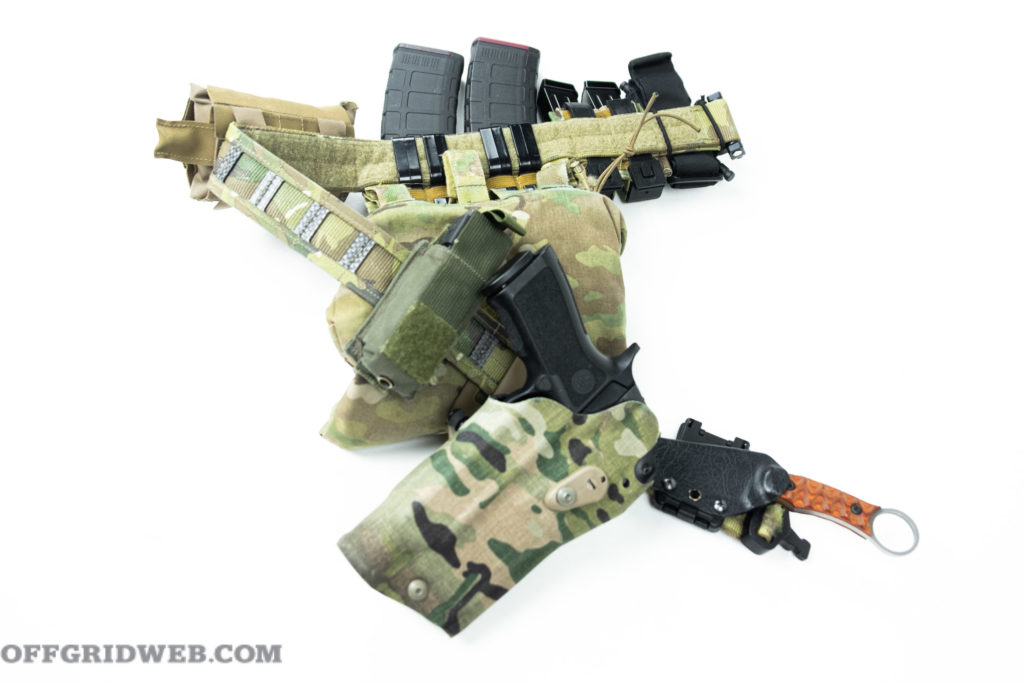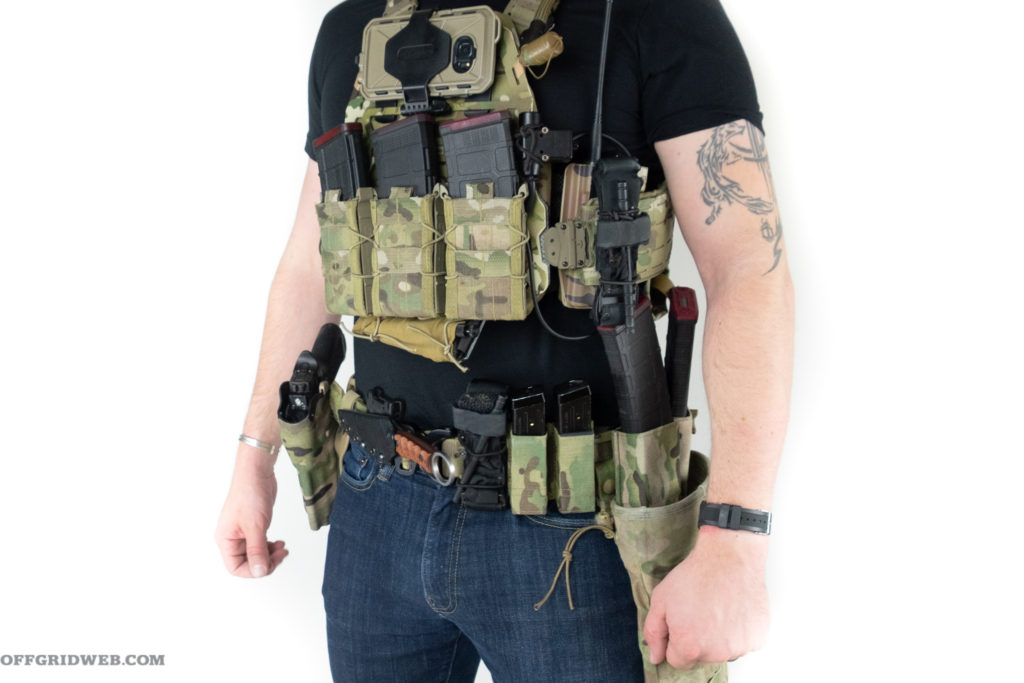RECOIL OFFGRID Gear GBRS Group Assaulter Belt: Carrying the Weight Without Adding Weight
In This Article
On the one hand, a best practice for reviewing duty/combat/survival gear is to compare and contrast it with other options available at the time. On the other hand, a belt of this type should also be independently considered for its objective features, and how they measure up under pressure. Earlier this year GBRS Group appeared in OFFGRID #43, bringing Tier 1 Tactical Training and the experience to back it. In addition to on-demand performance and instruction, they have recently dropped a belt built by LBT for special operations: the GBRS Group Assaulter Belt. From out of the bag, to on the range, to out in the field, it takes time for the belt to settle in, but once it does: it's time to take notes.
Beginning with the context, if you were to look at assaulter/war/battle belts over the last 13 years, you might be concerned that we've simply gone full circle, back to where we started. The floppy, slim, sleeve-like “belts” of 2008, which nearly required suspenders were replaced by the thicker, taller, and more rigid “battle belt” design. The mutli-belt variation eventually crept from the 3-Gun and USPSA world into more tactical lines of gear, and while the GBRS Group Assaulter belt may look like this style at first glance, it has vastly different properties than the distinctly rigid comp gear.

Top: Protective Shroud. Mid: Inner Belt. Bottom: Rigged Up Outer Belt.
Out of the packaging, the GBRS Group Assaulter Belt system includes a thin inner belt, the main load-bearing belt, and a third cover-belt of sorts that is to protect the hook interface when the outer belt isn't being worn. Instead of following the tradition of competition gear, which put the hard side, or hook side of the velcro/hook and loop tape on the inside of the outer belt, GBRS chose to put the soft side facing one's body. Thus, the third cover belt is there to protect the hard side/hook side when wearing it in an EDC fashion.

The outer belt gets its structure from a thin and lightweight, semi-rigid thermo-polymer, allowing it to bear pistol and rifle magazines, med kits, holsters, hatchets, knives, and more. In comparison to other belts of its type, the GBRS Group Assaulter Belt feels remarkably light, and although it will flex more horizontally (on the z axis), the vertical (y axis) play is still minimal, just the way a belt like this needs to flex. One layer in from the thermo-plastic core, Type 13, 1-23/32” belt webbing provides the tensile strength, to a measure of 7000 pounds.

Where some use rigid material such as scuba webbing to give a belt its form, with the Molle or similar interface attached to that, the GBRS Group Assaulter Belt has laser-cut holes in the thermo-polymer that act as the mounting spot for pouches. Effectively gaining two properties with one layer: modularity and form. A cobra buckle seals the deal, with a D-ring for either a safety lanyard or rappelling device, although the belt is in the process of testing and certification. Until then, keep it on the range.
The bad news of the belt is that it's quite difficult to mount gear onto it. The payoff, however, is that once mounted, the equipment fits securely and tightly to the body. The Molle/PALS like interface of the thermo-polymer tightly engages with whatever pouches are mounted and favors some methods over others such as Malice Clips. Gone are the days of pouches twisting and jostling about, but genuine work must be put in to get them there. A Tek-Lok will fit over the whole outer belt without problems, and although they can be used, the Esstac belt mounts must be removed from the mag caddie first, then re-connected mid-belt. One end of the belt is permanently affixed to the D-ring side of the Cobra Buckle, the other has a flaring of the thermo-polymer for holster support, or branding. Either way, the user will have to do a little tinkering to get everything to fit, but once it does, it's secure.

The Branding Block effectively prevents EssTac Kywi's from being slid directly onto the belt.
The pile/loop/soft side that runs on the inside of the outer belt allows the user to throw it on in an emergency, something uniquely pressing to those on the fighting edge of the military, and gives some credence to the design. In the event that there's no time to set the outer belt onto the inner belt, it can be thrown on without having to plan a trip to the med shed after the hard work is done. The inner belt, however, is so thin and light that it adds very little by means of support when attached. Instead, it adds one more restraint to keeping everything in place when sprinting, jumping, vaulting, or taking an aggressive knee under night vision goggles.
As if taking inspiration from Thomas Kuhn in The Structure of Scientific Revolutions, the changes in gear trends rarely follow a clean trajectory. That is to say, if someone were to try to draw a path through the development of load bearing tactical gear, they would not be able to keep it straight, but rather cyclical, as new threats, technological advancements, environments, and relationships between manufacturers and end-users develop and change the landscape of equipment. The GBRS Group Assaulter Belt, in the last ten years, has arrived in its time.

The belt fits right in with high end equipment. Gear shown on Plate Carrier: (Front) S&S Precision...
With the soldier, SEAL, or Ranger in mind, the ability to reduce weight while actually maintaining if not improving load-bearing capability is one thing. For those on the competition field, a little more weight on the hips will rarely make a difference. But for those doing 3-5 km infils on a target area, where and how the weight rests on your hips will impact long-term endurance. Many a Ranger Private has been warned not to put too much weight on his hips, lest he restrict the blood to his legs, tiring him out quicker.

The GBRS Group Assaulter Belt system integrates, if not improves the current commonality amongst upper-echelon warfighters to move some of the equipment from their plate carrier or chest rig to their belt, if not for weight, then for speed. After going through the work of installing AR-15 magazine carriers like Esstac Kywi's or G-Code Scorpions, they feel like part of one's body, agile in CQB situations, and secure in aggressive sprints. A Safariland Holster can either be shifted slightly forward on the hip for a clean fit, or kept closer to the 3 o'clock and used in tandem with a leg strap.
After ten years of the everyday wear of the Ares Gear Ranger, built heavily with scuba webbing, the lighter weight buckle-less design of the GBRS inner belt and shroud support a full-size pistol carried appendix without a problem when worn with the protective shroud. Wedging the belt clip of a holster between the layers only adds confidence to a draw-stroke as the holster remains secure. Despite its near weightlessness, the foundation is comfortable, even as it gets bent by belt loops. It's clear that the primary objective was weight reduction.
 Does the GBRS Group Assaulter Belt base layer make for a good EDC belt? Yes and no. Until a Black version is released, it comes in Multicam, which in some places it is viewed as a mere random fashion choice, in others, like Minneapolis, it'll draw attention at the time of writing. Make no mistake, you're not taking off your pants in a steamy, sexy slow-motion smooth maneuver, instead, it's the tearing sound of hook and loop fastening. In regards to EDC gear, this is chastity belt secure, however. What's attached is staying attached.
Does the GBRS Group Assaulter Belt base layer make for a good EDC belt? Yes and no. Until a Black version is released, it comes in Multicam, which in some places it is viewed as a mere random fashion choice, in others, like Minneapolis, it'll draw attention at the time of writing. Make no mistake, you're not taking off your pants in a steamy, sexy slow-motion smooth maneuver, instead, it's the tearing sound of hook and loop fastening. In regards to EDC gear, this is chastity belt secure, however. What's attached is staying attached.
To answer the easy question, the GBRS Group Assaulter Belt is worth the cost of entry, without a doubt. In a progression from early 2000's frameless belts, to VTAC Brokos Belt, to Ronin Tactics Senshi, this belt is the next step in the natural progression.
The worst thing that can be said about it is that it's not for casuals, at all times. The inner belt and cover are not going to ultimately replace everyone's EDC belt, and is the most likely wear point on the belt as a whole. This is easily solved by purchasing a spare set, should they become available.

True to its roots as an end-user designed piece of gear, the GBRS Group Assaulter Belt would greatly improve the lives of those going to war. For those on the homefront, it stands out amidst a sea of options, distinguishing itself as a adept fusion of lighter weight, supporting semi-rigidity, and secure attachment, if you'll put in the work for it.
Sizes: S/M, L/XL
Colors: Multicam, Black (as of 1300 Eastern, 1 July 2021)
S/M Specs
Fits: 30-35 waist size
Inner Belt Weight: 1.9 ounces
Outer Belt Weight: 11.1 ounces
Outer Belt Webbing OAL: 46 inches, with 13 inches of adjustability.
L/XL Specs
Fits: 36-42 waist size
Inner Belt Weight: 2 ounces
Outer Belt Weight: 11.5 ounces
Outer Belt Webbing OAL: 51 inches with 14.5 inches of adjustablilty
MSRP: $255
URL: gbrsgroupgear.com
 STAY SAFE: Download a Free copy of the OFFGRID Outbreak Issue
STAY SAFE: Download a Free copy of the OFFGRID Outbreak Issue
No Comments